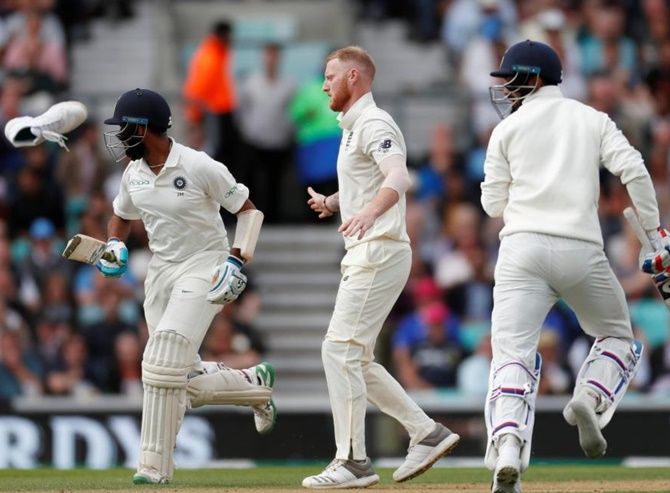The Indian team boosts ECB revenues.
No wonder that the ECB wants India to come as often as possible and for full five-Test series, regardless of their poor showing, reports Ashis Ray.

Amid much anticipation, India's baptism in Test cricket occurred in 1932 with a maiden appearance at the Lord's Cricket Ground, London. Three decades later, though, a certain pessimism about India's prospects had surfaced at the home of the game following a 5-0 whitewash in 1959.
Michael Colin Cowdrey, an eminent English batsman, deprecatingly suggested that the Test playing sides be divided into two leagues, with India figuring in the lower bundle.
Indeed, eight years passed before India were invited back to England, that too, for a downgraded three Test contest.

India won its first Test and series in England under Ajit Wadekar in 1971. But it was not until 1979 that the Indians were granted a four-Test encounter in England. However, this reverted to the status quo ante from the very next tour in 1982.
Not even Kapil Dev's team outplaying the hosts in the first half of the summer -- when seam and swing dominate -- in 1986 made a difference.
The Test and County Cricket Board -- as it was then known, now the England and Wales Cricket Board -- did not increase the number of Tests between the countries until 2002, only to retreat to three in 2007 (when Rahul Dravid's team defeated England), before restoring it to four in 2011.
In 2011, India again lost in every Test -- a humiliation not suffered since 1974.
Many thought the ECB would condemn India back to the three-Test category or worse. But just the opposite happened.
India were elevated to the uppermost echelon of five Tests -- only the second team after Australia to be bestowed the 'honour' currently.
Not only did England achieve a clean sweep against India in 2011, but in subsequent series in 2014 and in the just concluded one, India were eclipsed 3-1 and 4-1, respectively.
However, realities have undergone a metamorphosis.
The ECB has benefited hugely from the India series by way of broadcast deals, food and beverages sales, irrespective of outcomes on the ground.
In the 86 years that India have been visiting England, the character of attendance at the Tests has changed from being almost entirely indigenous faces to up to a third of the crowd being of Indian origin.
Stars like Sunil Gavaskar, Kapil Dev, Sachin Tendulkar and, now, Virat Kohli have drawn admiration and audiences from English connoisseurs.
According to Andrew Walpole, the head of corporate communications at the ECB, "25,000 more tickets overall" had been sold at the start of this summer's series than was the case four years ago.
That figure would have increased substantially in the end. "The huge following of the game in India is clearly beneficial for us in all kinds of ways, from generating broadcast deals -- both the UK and overseas rights deals -- to attracting new sponsors," Walpole added.
Additionally, the efficient and elaborate food and beverage sales at fixtures would run into multi-million pounds.
Overseas TV licences are generally sold by the ECB over four-year periods.
With a tour by India now a constituent of such concessions, the biggest component of the revenue could be emanating from Indian broadcasters -- previously Star, presently Sony.
Also, there were as many hoardings of Indian companies behind the boundary lines as British.
The ECB's financial statement for the year ended January 31, 2017 indicates an income of £119 million and an expenditure of £156 million. In other words, a loss of £37 million.
In the year ended January 31, 2018, the accounts showed a loss of £27 million.
In the next submission, though, with the turnover from the India visit included in it, the ECB expects to make a profit.
In short, quite significantly, the presence of the Indians appears to be compensating for the shortfall of other years.
No wonder, then, the ECB wants India to come as often as possible and for full five-Test series, regardless of their poor showing on the past three occasions.

India arrived in England this year wearing a misleading mantle of being the number one ranked Test playing nation.
That position has been created on docile Indian conditions or, at best, on equally slow and low wickets in Sri Lanka.
Admittedly, India won in the Caribbean 2-0 in 2016. But are the West Indies today any opposition in Tests?
In contrast, India lost 2-1 in South Africa last winter and have just been meted another drubbing in England.
The English batting has rarely been as brittle as now. Their pace attack is spearheaded by an aging duo of James Anderson and Stuart Broad. Yet, India could not deliver a coup de grace.
After England's bleak showing over the winter, English supporters were fearful that profit for the ECB could turn out to be a loss on the field. Instead, it has transpired to be a win-win.













 © 2025
© 2025